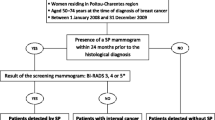Abstract
Background
A nationwide breast cancer screening program was introduced in Hungary in the year 2002 for women aged 45–65 years to be performed biannually.
Methods
To investigate and report the short-term and 10-year follow-up results, we analyzed our Breast Unit’s prospectively led database of screened (Group A) and age-matched symptomatic (Group B) patients from 2002 to 2007. We compared the clinicopathologic features of tumors and the impact of screening on surgical treatment, as well as the overall (OS), disease-specific (DSS) and disease-free survival (DFS) of different groups.
Results
Data from 208 screen-detected and 101 symptomatic patients between 45 and 65 years of age were examined. Screen-detected women were younger (54 vs. 58.5 years; p = 0.001) had significantly smaller tumors (15.5 vs. 17 mm; p = 0.044), and more breast-conserving surgery (68.8 vs. 59.4%; p = 0.032). Survival statistics were not statistically different at the median follow-up of 123 months; however, there was a trend toward improved DFS in Group A (82.7 vs. 74.3%; p = 0.074).
Conclusions
Our study showed a significant reduction in rates of mastectomy in the screen-detected group in the short term, which does not translate into better survival rates based on initial long-term data. In order to realize the real advantage of this newly enstated screening program, a longer period of investigation is needed.

Similar content being viewed by others
References
Ferlay J, Soerjomataram I, Dikshit R et al (2015) Cancer incidence and mortality worldwide: sources, methods and major patterns in GLOBOCAN 2012. Int J Cancer 136(5):359–386
Kásler M, Ottó S, Kenessey I (2017) The current situation of cancer morbidity and mortality in the light of the national cancer registry. Orv Hetil 158:84–89
WHO Position Paper on Mammography Screening (2014) World Health Organization, Geneva. Available from: https://www.ncbi.nlm.nih.gov/books/NBK269545/
Mandelblatt JS, Stout NK, Schechter CB et al (2016) Collaborative modeling of the benefits and harms associated with different U.S. breast cancer screening strategies. Ann Intern Med 164(4):215–225
Sobin LH, Gospodarowicz MK, Wittekind C (2011) TNM classification of malignant tumours. Wiley, Oxford
Újhelyi M, Pukancsik D, Kelemen P et al (2017) Reasons of non-attendance for organized breast cancer screening programme in Hungary—questionnaire of 3313 cases. Magy Seb 70(2):183
Dillon MF, Hill ADK, Quinn CM et al (2004) Surgical intervention in screen-detected patients versus symptomatic patients with breast cancer. J Med Screen 11:130–134
Norden T, Thurfjell E, Hasselgren M et al (1997) Mammographic screening for breast cancer. What cancers do we find? Eur J Cancer 33:624–628
Újhelyi M, Pukancsik D, Kelemen P et al (2016) Does breast screening offer a survival benefit? A retrospective comparative study of oncological outcomes of screen-detected and symptomatic early stage breast cancer cases. Eur J Surg Oncol 42:1814–1820
Delaney G, Shafiq J, Chappell G, Barton M (2008) Establishing treatment benchmarks for mammography-screened breast cancer population based on a review of evidence-based clinical guidelines. Cancer 112:1912–1922
Spillane AJ, Kennedy CW, Gillett DJ et al (2001) Screen-detected breast cancer compared to symptomatic presentation: an analysis of surgical treatment and end-points of effective mammographic screening. ANZ J Surg 71:398–402
Freedman GM, Anderson PR, Goldstein LJ et al (2003) Routine mammography is associated with earlier stage disease and greater eligibility for breast conservation in breast carcinoma patients age 40 years and older. Cancer 98:918–925
de Koning HJ, van Oortmarssen GJ, van Ineveld BM et al (1990) Breast cancer screening: its impact on clinical medicine. Br J Cancer 61:292–297
Samnakay N, Tinning J, Ives A et al (2005) Rates for mastectomy are lower in women attending a breast-screening programme. ANZ J Surg 75:936–939
de Haes JC, van Oostrom MA, Welvaart K (1986) The effect of radical and conserving surgery on the quality of life of early breast cancer patients. Eur J Surg Oncol 12(4):337–342
Gøtzsche PC, Jørgensen KJ (2013) Screening for breast cancer with mammography. Cochrane Database Syst Rev 6:CD001877
Nyström L, Andersson I, Bjurstam N et al (2002) Long-term effects of mammography screening: updated overview of the Swedish randomised trials. Lancet 359(9310):909–919
Zamora LI, Forastero C, Guirado D et al (2016) A Monte Carlo analysis of breast screening randomized trials. Phys Med 32(12):1609–1614
Morrell S, Taylor R, Roder D, Robson B, Gregory M, Craig K (2017) Mammography service screening and breast cancer mortality in New Zealand: a national cohort study 1999–2011. Br J Cancer 116(6):828–839
Nyström L, Bjurstam N, Jonsson H, Zackrisson S, Frisell J (2017) Reduced breast cancer mortality after 20+ years of follow-up in the Swedish randomized controlled mammography trials in Malmö, Stockholm, and Göteborg. J Med Screen 24(1):34–42
Massat NJ, Sasieni PD, Tataru D et al (2016) Explaining the better prognosis of screening-exposed breast cancers: influence of tumor characteristics and treatment. Cancer Epidemiol Biomarkers Prev 25:479–487
Author information
Authors and Affiliations
Corresponding author
Ethics declarations
Conflict of interest
The authors declare that they have no conflict of interest.
Rights and permissions
About this article
Cite this article
Tóth, D., Varga, Z., Tóth, J. et al. Short- and Long-Term (10-year) Results of an Organized, Population-Based Breast Cancer Screening Program: Comparative, Observational Study from Hungary. World J Surg 42, 1396–1402 (2018). https://doi.org/10.1007/s00268-018-4486-0
Published:
Issue Date:
DOI: https://doi.org/10.1007/s00268-018-4486-0




